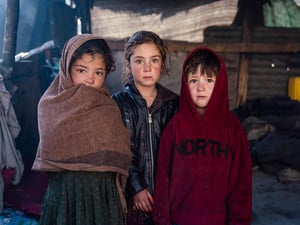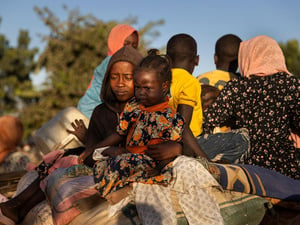UNHCR pushing aid out across Syria as winter looms
UNHCR pushing aid out across Syria as winter looms
Syria's on-going conflict continues to complicate efforts to address the humanitarian needs there. On 14th October UNHCR relief aid was delivered to some 2,500 people from Mouadamiya, to the southwest of Damascus. These people had just been evacuated and are now in collective a centre in Dahyet Qudsaya. As well as monitoring their general condition and protection concerns, mattresses, blankets, cooking sets, hygienic supplies and other aid was handed out.
Last week, UNHCR's local partners also brought aid within the hard-to-reach city of Raqqa to more than 10,000 people. The recipients included more than 3,600 people sheltered at the Al Riyayat school and Massahadah farm. Raqqa, located about 160 kilometers east of Aleppo, hosts internally displaced persons from Aleppo and Deir es Zour.
Just prior to the recent Eid holiday, on 10th and 13th October, we participated in two inter-agency convoys to Ter Maela and Al-Ghantoo, near Homs. Relief items were provided to 10,000 vulnerable people. Our teams observed that many of the displaced are living in buildings lacking windows, doors and electricity. People in this area will soon urgently require thermal blankets and plastic sheets to deal with winter temperatures. Women told us they lacked privacy in the collective shelters.
So far this year, about 35 per cent of UNHCR's core relief has gone to people in hard-to-reach areas such as Aleppo, Azzaz and Karameh. Since February, we have participated in 21 inter-agency missions to hotspots including Karameh, Aleppo, Idleb, Hama, Homs, Dier es Zour and Dara'a.
UNHCR's work inside Syria aims at delivering relief aid to three million people. This allows people to feed their families, it ensures access to shelter, and it helps people cope with displacement and maintaining hygiene. On a weekly basis up to 250 aid trucks are on the move inside Syria, bring aid to some 14,000-15,000 households, equivalent to nearly 100,000 people weekly.
Despite this effort, the needs within Syria are enormous and displacement is on-going. Current UN estimates are that there are more than 4.25 million people who are internally displaced, but that figure is nearly five months old and likely to be revised upwards. Beyond those who are displaced, millions of other Syrians are impoverished and lack medical and other aid.
Temperatures are now dropping across the region and together with the rest of the aid community we are in a race to help people prepare for Syria's third winter amid conflict. Earlier this month we began distribution of "winterized" core relief across Syria: items such as thicker thermal blankets and additional plastic tarpaulins meant to help one million displaced persons. We have so far rehabilitated shelters hosting 35,000 of the 80,000 people we want to reach before winter sets in. These displaced persons live in informal and unfinished shelters - facilities often with no heating, doors and windows. UNHCR also provides financial assistance to vulnerable IDPs in Damascus, rural Damascus, Homs, Al Hassakeh, Qamishly and Tartous. This has so far benefited more than 117,000 displaced and vulnerable Syrians.
Last week the first half of 44 shipping containers loaded with UNHCR aid from our Central Emergency Stockpile arrived in Tartous and the remaining containers are expected shortly. This shipment of large 40 foot containers includes more than 29,000 plastic tarpaulins, 150,000 sleeping mats, 75,000 jerry cans and 30,000 kitchen sets which will be delivered over the coming months to our beneficiaries across a wide swathe of northern Syria. In addition to deliveries via sea, UNHCR also sends items into Syria via its regional stockpile based in Jordan.
Virtually every town and city in Syria is affected by the conflict or hosts traumatised, displaced people. According to UN statistics, more than 400,000 homes have been destroyed and 1.2 million damaged. As many as 5,500 schools and 3,800 mosques have been damaged or destroyed. Most flour mills and bakeries are no longer operating. Hospitals offer no sanctuary for healing - 57 per cent are damaged and 60 per cent of ambulances are out of service. 15,000 doctors left the country, leaving an acute shortage of health personnel as well as the medicines and equipment to treat a growing population of sick and wounded.
Increasing numbers of the internally displaced are living in squalid conditions in abandoned public buildings, including in 931 schools but also in hospitals, basements and mosques. Some 180,000 especially needy people live in 983 collective shelters across Syria. Mostly home to women, children and the elderly, UNHCR has witnessed shelters with missing doors and windows and lacking proper sanitary conditions. Leishmaniasis and cholera are reportedly becoming increasingly common.
We are concerned that the breakdown of a sense of community and safety is harming children in particular. Almost two million have dropped out of school and growing numbers are being exploited for labour or recruitment into armed groups. There are many cases of children having been separated from parents, and many live in a state of trauma and fear. With food insecurity affecting over four million people, two million children face malnutrition and we constantly hear alarming reports. UNHCR is also concerned about the vulnerability of women, many heading broken households.
For more information on this topic, please contact:
- Peter Kessler (Amman) +962 79 631 7901 [email protected]
- Adrian Edwards (Geneva) +41 79 557 9120 [email protected]







